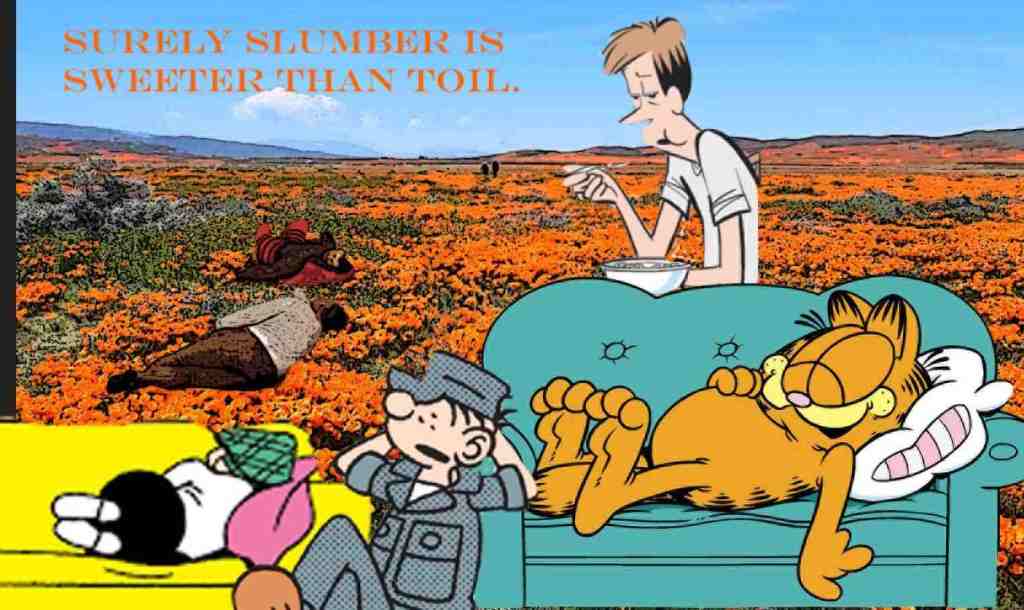
Certainly some sociologist has studied why laziness is so predominant a vice among male protagonists in newspaper comic strips. Alas, I’m too slothful myself to really attempt to find that research. My halfhearted Google search has yielded nada. Yet, I’m curious: this comic celebration of lassitude must be indicative of something in the American character.
I read the comics every day as part of my morning ritual, starting with “Andy Capp,” who lolls around the house on the dole while his wife Flo slaves away both at work and at home. Meanwhile, if Andy’s not conked out on the sofa, he’s gambling, playing football, hitting up acquaintances for booze money, brawling, or standing trial. Most nights, his nose aglow, he stumbles into the canal on his way home.
In fact, if you pronounce his name with a Northern England accent it sounds like “handicap.” This strip has been around since 1957, it’s syndicated in 13 languages, so obviously lots of people enjoy his antics. Laziness delights!
Next I read Lincoln Pierce’s “Big Nate,” which has replaced “Dilbert” in our paper.
Nate Wright, the protagonist of the strip is a lazy, rebellious 6th grader who attends Public School 38. Like his distant relative Andy Capp, Nate spends much of his time in detention. He’s much more likeable than Andy, though. However, his nose is on the side of his head cubist-style, which bothers me for some reason.

I skip “Grand Avenue” and read “Zits” next. In this morning’s iteration, Jeremy’s mom is trying to rouse him from bed while he’s attempting “to mentally bend time and space,” so he “can be at school without leaving [his] bed.” His mom mentions that he’s still in his boxershorts.
Do you see a pattern here?
The next few strips I read don’t fully align with the laziness trope – “The Wizard of Id,” “Luann,” “Mary Worth,” and “Hi and Lois.”[1]
Which brings us to “Beetle Baily” who makes Faulkner’s Anse Bundren look like a human dynamo.[2]
Once again, “For Better or Worse,” Sally Forth,” “BC,” “Hagar the Horrible,” “Blondie,” and “Peanuts” don’t celebrate sloth, so that leaves us with “Dustin” and “Garfield,” who also epitomize lassitude.
In today’s strip, twenty something Dustin announces at breakfast that he’s landed “a big job with a hefty salary, benefits, and a company car.” His sister Megan asks, “April Fool’s,” and indeed today is the first of April.
Perhaps Garfield is the most famous of this lazy crew, a gluttonous cynic and egocentric extraordinaire. His half hooded eyes say it all. But people adore him. He’s a hot selling stuffed animal, and I’ve even seen him imprinted on beach towels. Bravo, Garfield!
So here’s the question: Why do we find these losers so amusing? Do they make us feel good about ourselves in comparison?
Do comic strip creators despise puritanism, the Protestant work ethic, and all that jazz?
Don’t ask me. I ain’t got a clue.
[1] You know you’re really old when Mary Worth starts looking good to you.
[2] Here’s how Anse’s son Darl describes his father: “The shirt across pa’s hump is faded lighter than the rest of it. There is no sweat stain on his shirt. I have never seen a sweat stain on his shirt. He was sick once from working in the sun when he was twenty-two years old, and he tells people that if he ever sweats, he will die. I suppose he believes it.”